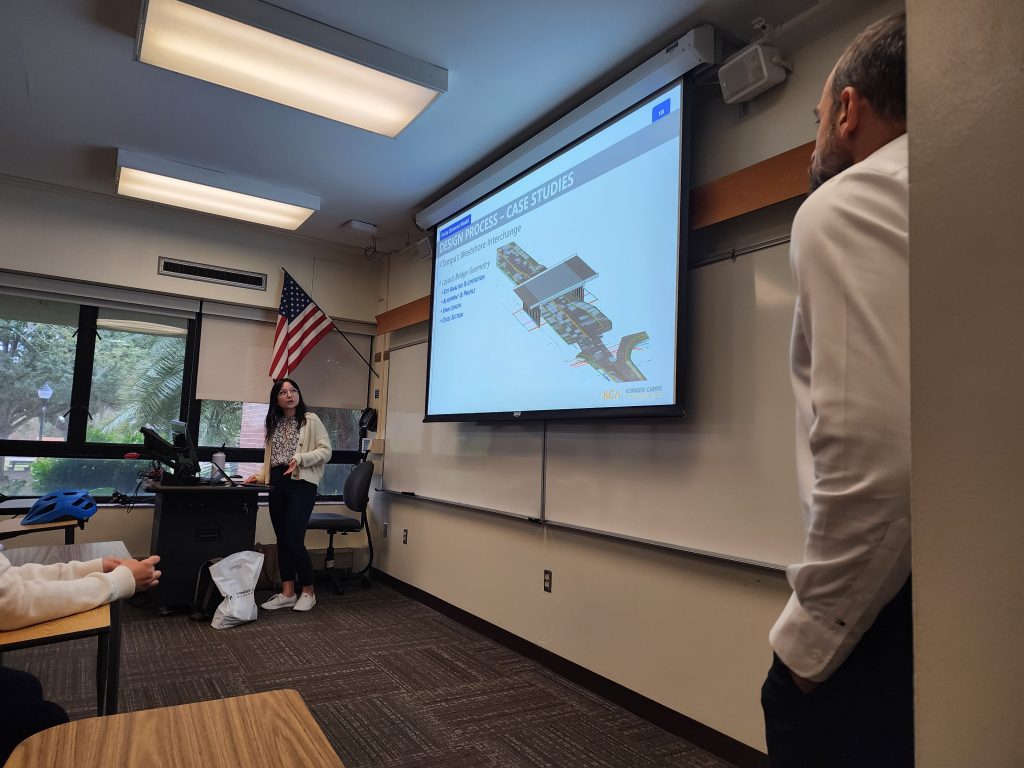By Ines Aviles-Spadoni, M.S., Research Coordinator and Reba Liddy, M.A., Marketing & Communications Specialist

Kisinger Campo & Associates, Corp., a multidisciplinary engineering firm and longtime supporter of the University of Florida’s Engineering School of Sustainable Infrastructure and Environment (ESSIE), came to campus in October to share real-world insights with graduate students in a finite element analysis (FEA) class. Engaging with partner companies helps students connect their coursework to real-world applications and serves as a valuable talent pipeline for companies.
Gary Consolazio, a civil engineering professor and FEA class lecturer, said industry presentations offer real-world insights that are difficult to communicate in class. They give students the opportunity to hear from current bridge designers to see when, how and why FEA is used in their work.
“Within the limits of class assignments, FEA can seem linear, starting at one point with a clear problem statement and ending at another point with clearly defined results,” Consolazio said. “In practice, the application of FEA is not linear nor one-directional. The presentation by KCA clearly demonstrated that FEA is often cyclic in that project changes, new information, or new constraints may force multiple re-analyses (and redesigns) of a structure.”
The KCA visitors included UF alumni Uni Chen (MSCE ‘21), structures engineer; Alfredo Layrisse (MSCE, ‘09), chief structures engineer; and Roger Rossitto, vice president of business development and talent acquisition. Chen and Layrisse presented the practical applications of finite element analysis in projects they have worked on, such as the Gateway Expressway Project, the Howard Frankland Bridge Replacement and the Pensacola Bay Bridge repair.
Chen, reflected on her time as a graduate student a few years ago, instead, she’s on the other side of the presentation.
“It’s common for students to feel that what they learned in school isn’t relevant once they enter the workforce, so I hope this presentation instilled some confidence in them regarding the value of their education,” Chen said. “It’s important to be patient with your learning experience. Focus on truly understanding the subject rather than just preparing for exams. This is a great time to develop a sense of responsibility for your designs.”
Layrisse said returning to campus reminded him of his days as a graduate student. Since 2019, Layrisse has been inspiring graduate students in Consolazio’s class and hopes they gain important takeaways from his presentations, including how to apply theory to real-world scenarios, the challenges engineers face and the importance of following rigorous safety standards to protect the public.
“Civil Engineering, specifically Structural Engineering, is a challenging and demanding career one must be passionate about, and I hope to pass that along,” said Layrisse. “This job requires collaboration among peers and various stakeholders, signaling the importance of effective teamwork and communication.”
Rossitto, who sat in the audience alongside the graduate students, was impressed by their knowledge of FEA and the questions they asked. He stressed how these presentations help bridge the gap between what the students learn in the classroom and how those concepts are applied in the industry. He noted the visit is mutually beneficial to the students to learn about real-world applications and to the company since this is a valuable recruitment opportunity for them, which allows them to spot passionate students with a natural curiosity for engineering.
“I was impressed by the class’s strong understanding of finite elements analysis theory and their active engagement with Alfredo and Uni’s presentation,” Rossitto said. “Several students even stayed after the session to continue the conversation.
“It’s an opportunity for us to connect with the next generation of engineers, helping them envision a possible future with KCA while strengthening our pipeline for top talent.”
Students in Consolazio’s s class, including Daleen Torres-Burgos, Laura Gonsoulin and Juan J. Torres, shared their perspectives about the KCA visit and the presentation.
Torres-Burgos, a doctoral student specializing in civil engineering, said the Pensacola Bay Bridge repair case connected to her interests in natural hazard mitigation and resiliency.
“I find it fascinating to see how FEA can aid in emergency bridge repairs following natural hazard events,” she said. “In the study, damaged components were modeled to determine repair strategies that ensured structural integrity, expediting the reopening of critical roads after an emergency.”
Laura Gonsoulin, who is completing her final semester for her master’s degree, said the information on element types and their applications helped solve a challenge she encountered in a recent internship,
“Earlier this summer, I had been tasked with using FEA software, and one of the issues that I encountered was deciding which element types to use,” she said. “While my internship was in building design, not bridge design, I found this presentation to be enlightening because it laid out the thought process behind how to construct a finite element model for specific applications.”
Torres, a doctoral student in civil engineering, said the presentation opened his eyes to the important role engineers play in public safety and the importance of communication in the multidisciplinary process.
“I think the aspect that people’s lives rely on the structure while they’re using the bridge for their various endeavors makes design and construction a really important part of the level of detail required,” he said. “One miscalculation could lead to failure, even on a correct design if the specified detailing is not ensured in the field during construction.”
KCA, a minority-owned, award-winning multidisciplinary engineering firm, has provided exceptional service to the transportation industry for nearly five decades. Their connection with UF is significant: More than 40 team members, including top senior executives, are UF alumni, reflecting the strong ties they maintain with the institution.
KCA’s commitment to ESSIE extends beyond hiring its graduates. Over the years, the company has contributed to the school through the Kisinger Campo & Associates Term Professorship, advisory board involvement, concrete canoe sponsorship, and participation in ESSIE’s “Evening with Industry” bi-annual career showcase.
Through its longtime partnership with ESSIE and its engagement with students and faculty, KCA is helping to shape the future of civil engineering.


